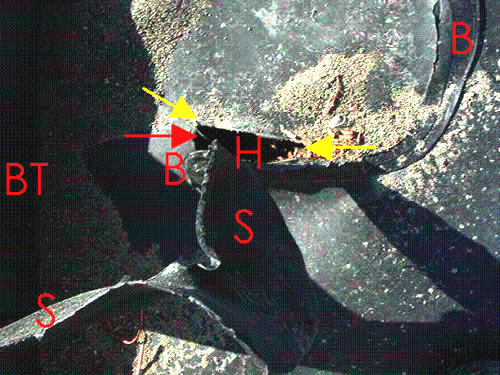When designing liners for ponds in which ice might form it is important to be careful with penetrations and appurtenances such as ballast tubes, particularly if water levels will change during the presence of ice. If the water level drops the support for the ice will be removed and the ice can collapse in large sharp fragments that can damage the liner. If the water level rises while ice is attached to pipe penetrations and other appurtenances, the rising ice can pull a hole in the liner where the appurtenance attaches to it. The ice will not adhere to the liner but it will mechanically clamp on to the appurtenance, such as a ballast tube and straps attaching it to the liner. Thus, it will tend to lift the appurtenance off the liner where it is bonded to the liner.
Figure 1 shows a ballast tube that has been displaced by ice and/or waves.
 |
| Figure 1. Displaced ballast tubes and broken straps. Straps welded to sacrificial strip. |
Figure 2 shows where a well-bonded fastening strip has pulled a hole in the liner.
 |
| Figure 2. Ballast tube (BT) and torn strap (S) extrusion welded with bead (B) to liner. The end of the U-shaped bead is the left B. Bead has been lifted to make a hole (H and red arrow) in the liner. The straight line between yellow arrows was the center of the bead at the edge of the strap . At the right B the strap material has torn at the edge of the bead. |
It would have been better to have had a weld that would have peeled in this non-sealing situation. If appurtenances are attached to a sacrificial strip which is then welded to the liner it is better to use a continuous extrusion bead than a series of tack welds; water (ice) must be prevented from getting behind the sacrificial strip.
Where ice is involved take care.











